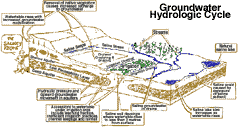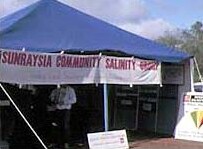Salinity Management
|
Since European settlement, the replacement of native vegetation with crops and pastures, and the rise of irrigation developments have resulted in changes to the water balance. |  Groundwater hydrologic cycle - recharge, discharge and salinity processes. Diagram: Simon Kneebone, 1988 Click on the diagram to view a larger resolution (26K)  |
Specific state-wide salinity control objectives are:
- to stabilise watertables at harmless levels in irrigation areas with good quality groundwater
- to significantly retard rising groundwater by control of groundwater recharge, and where necessary to adapt to higher saline conditions in irrigation areas with saline groundwater
- to significantly reduce accessions to the groundwater systems and to substantially improve salinity problems associated with localised groundwater systems
- to protect, and where appropriate, rehabilitate high value wetlands and other significant environmental features.
Related Links
| Murray-Darling Basin Salinity Management Strategy. Information about the 15 year Basin Salinity Management Strategy (2001-2015) on the Murray–Darling Basin Authority website. Includes downloadable documents. |
| Murray-Darling Basin Salinity Audit. Provides detailed predictions for all major river valleys in the Murray-Darling Basin for the next 20, 50 and 100 years. |
| Effectiveness of Current Farming Systems in the Control of Dryland Salinity (external link). A downloadable CSIRO publication on the Murray–Darling Basin Authority website. To view the information PDF requires the use of a PDF reader. This can be installed for free from the Adobe website (external link). |
| The Department of Agriculture, Fisheries and Forestry Australia website provides a range of documents related to Salinity Risk Management (external link) in Australia (including: the salinity problem; integrated salt risk characterisation and salinity risk management). |
| Information about salinity (external link) on the Australian Academy of Sciences website. |
| The House of Representatives Standing Committee on Science and Innovation tabled its report on June 21st 2004 - entitled Science overcoming salinity: Coordinating and extending the science to address the nation's salinity problem. A copy of the entire report is available for download on the Parliament of Australia House of Representatives website. |
| The Australian Government's Department of Agriculture, Fisheries and Forestry website provides a range of salinity information (external link) (including major programs and initiatives, research and development, salinity advice and salinity monitoring and assessment) as well as information about the National Dryland Salinity Program (external link) (including salinity mapping methods, Groundwater Flow Systems, desalinisation technologies and the Australian Dryland Salinity Assessment 2000). |


